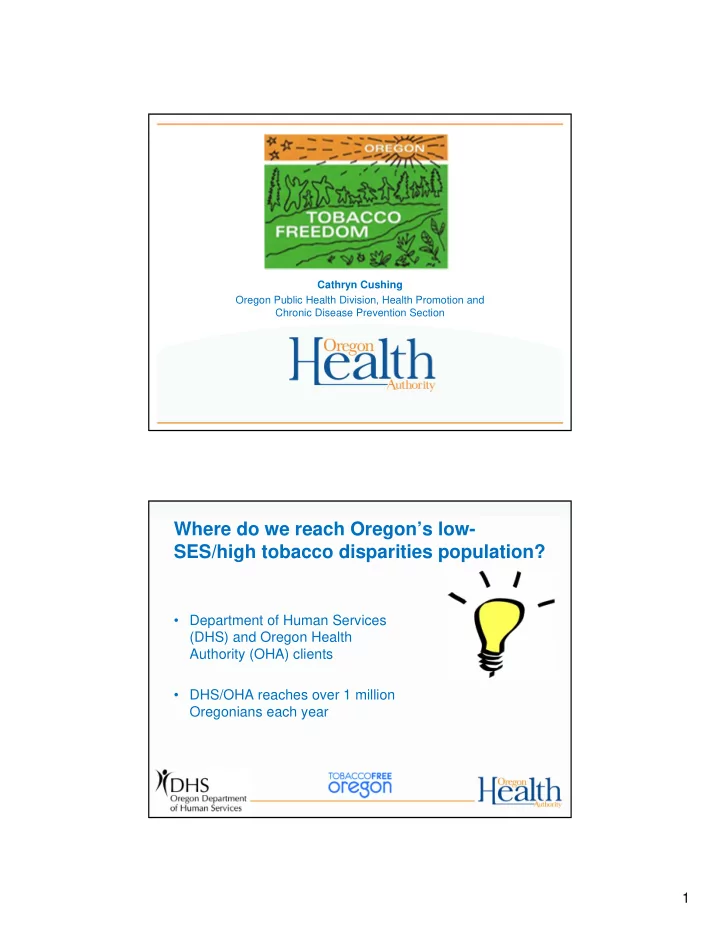

Cathryn Cushing Oregon Public Health Division, Health Promotion and Chronic Disease Prevention Section Where do we reach Oregon’s low- SES/high tobacco disparities population? • Department of Human Services (DHS) and Oregon Health Authority (OHA) clients • DHS/OHA reaches over 1 million Oregonians each year 1
TCIP = What the Tobacco Prevention and Education Program (TPEP) knows about tobacco control + What the DHS/OHA Divisions know about their clients and workforce 3 Tobacco Use Disparities Smoking prevalence among Oregon adults – 2011 BRFSS 10.1% • With annual incomes more than $50,000 = 35.9% • With annual incomes less than $15,000 = • Insured (including private) = 14.9 % •Uninsured = 33.9% • Medicaid (OHP) = 37.8% • Medicaid (OHP) cost, per year, to treat smoking ‐ attributable disease = $374 M 4 2
TCIP and SNAP ( Food stamps ) • The average household SNAP benefit is: $250 per month . • At one pack per day, two adults will spend more on cigarettes ($300) in a month than their family receives in nutrition benefits. ARRA Goals • To increase 100% tobacco-free or smokefree policies in facilities serving DHS/OHA clients • To increase policies requiring promotion of, access to and delivery of cessation resources to DHS/OHA clients and employees • To implement a hard hitting counter-advertising campaign targeted to people with fewer resources • To raise the price of tobacco by 10% 3
TCIP successes – Homecare Worker policy – distribution of cessation resources – Tobacco-free campus policy for residential treatment for mental health and addictions – Survey of cessation resources provided by health plans serving Medicaid clients – Language about tobacco-free campuses and cessation resources for employees in all Public Health Division RFP’s – Distribution of quit cards at all human services points of access – Quit Line number on hold messages and web buttons – Workgroups forming to discuss tobacco-free campuses for residential treatment for people with developmental disabilities and seniors – High level cross-agency sponsorship of the project – now CAHIP 8 4
Addictions and Mental Health Readiness for policy change • Morbidity and Mortality in People with Serious Mental Illness Oct. 2006 http://www.nasmhpd.org/publicationsmeddir.cfm – People with serious mental illness served by public mental health systems are dying 25 years earlier than the general population 30%-40% due to suicide & injury 60% due to medical conditions • cardiovascular disease (most deaths – link to smoking, obesity) • diabetes (link to obesity, high risk in schizophrenia) • respiratory diseases (link to smoking) • infectious diseases (HIV, HEP C, TB – made worse by smoking, obesity) 9 Readiness for policy change, cont. • Oregon’s report containing results of seven years of mortality data analysis – 2008 – Oregonians with mental illness and substance abuse disorders are dying approximately 35 years before the general population • Addictions and Mental Health Division Wellness Initiative – 2008 • Tobacco Freedom Summit - 2009 5
Tobacco Freedom Goals • Giving consumers the ability and the choice to become tobacco-free – Providing treatment facilities and grounds free of tobacco • Assisting individuals to achieve personal health and wellness – Creating a network of peer-based cessation resources – Improving discharge planning to promote sustained tobacco cessation and healthy lifestyle recovery Tobacco Freedom Activities • Tobacco Freedom luncheon with consumer/survivor advocates and leaders • Peer-to-peer tobacco dependence recovery training and materials for Peer Specialist and care services staff • Policy implementation training for addictions and mental health facility administrators, managers and staff 6
Tobacco Freedom Facility Assessment • Assessment of tobacco-related policies, procedures and attitudes at all state-funded facilities http://www.cdc.gov/pcd/issues/2012/11_0080.htm • 98% of facilities interviewed by telephone (162 out of 166) • 15% had 100% smokefree campus policies • 47% offered cessation resources at discharge • Fewer than 10% of facilities interviewed expressed opposition to the future requirements Tobacco Freedom Activities… cont’d • Tobacco Freedom website for consumers, facilities and providers http://www.oregon.gov/OHA/addiction/tobacco-freedom/main.shtml • Art contest for the art work of the tobacco-free signs www.flickr.com/photos/tobaccofreedom • Community Drop-In centers providing tobacco cessation groups • Clinician-assisted tobacco cessation training for behavioral health providers 7
Tobacco Freedom Policy • Adopted 10/1/11 • Implemented in two phases January 1, 2012, all addictions and mental health services and supports will include tobacco cessation July 1, 2012, staff, individuals receiving services, volunteers and visitors shall not use tobacco in any form (including cigarettes, electronic cigarettes, cigars, pipes and smokeless tobacco) on the grounds, including parking areas, of programs licensed and funded by the State Division of Addictions and Mental Health. And, tobacco products will not be provided by staff. Bumps in the Road • Leadership changes • Implementation delay for some facilities • How Oregon provides residential mental health services • Resources allocated to residential mental health services • Neighbor to neighbor relations 8
Lessons Learned • Involve stakeholders early in the process • Have leadership support as high up the ladder as possible • Share success stories early and often Contact Information Cathryn Cushing Oregon Public Health Division (971) 673 ‐ 1013 cathryn.s.cushing@state.or.us 18 9
Recommend
More recommend